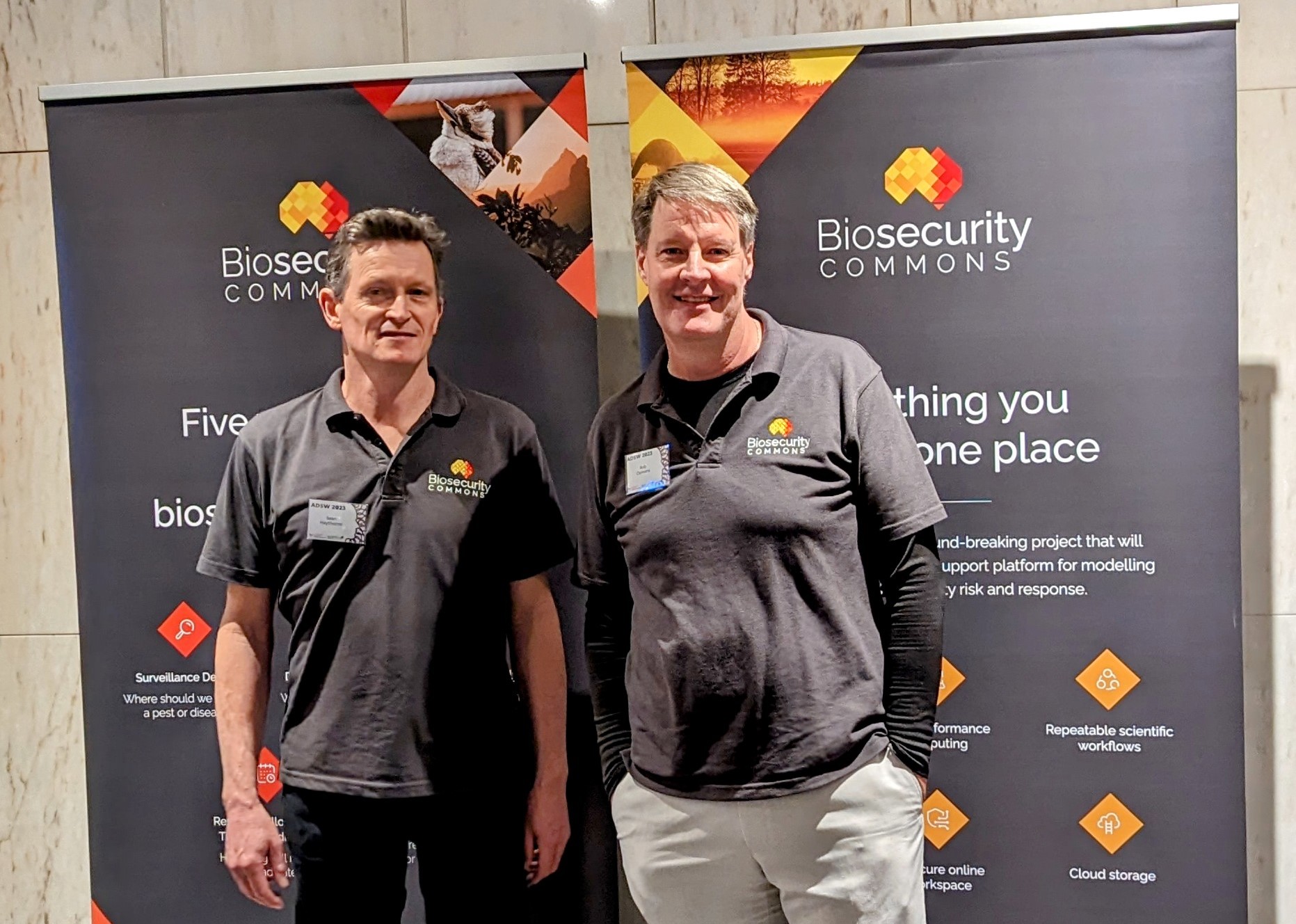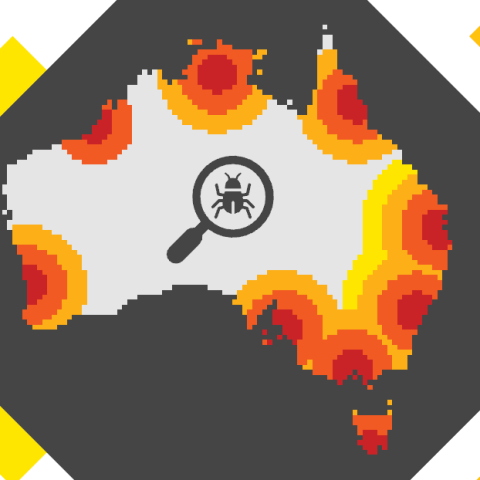Photo: At the Biosecurity Commons launch, from left to right: Sean Haythorne, Research Software Engineer at CEBRA, and Rob Clemens, Biosecurity Commons Project Manager.
Brisbane, Queensland – A new biosecurity project is set to play a transformative role in protecting Australia from the arrival of invasive species that threaten the economy and the environment.
Biosecurity Commons is a ground-breaking platform that will change how we analyse and respond to biosecurity threats such as plant pests, weeds or diseases arriving with air and sea cargo, passengers or mailed parcels.
The platform can provide information about where to look for a disease or pest, where it might spread to, what impacts it might cause, how long it will take to eradicate, and when a region is free from it.
Previously, finding answers to these questions would have required significant work. However, Biosecurity Commons is set to change this by bringing together vast quantities of invasive species data and a suite of sophisticated analytical tools into one platform that only requires a web browser to run.
The Biosecurity Commons team has already demonstrated that the platform can easily and much more quickly reproduce the results of a scientific paper* which predicted the spread of orange hawkweed (Hieracium aurantiacum), an invasive species of daisy that could seriously degrade Australia’s alpine ecosystems.
Biosecurity Commons simplifies the investigation of specific biosecurity questions like this, which will lead to better biosecurity outcomes.
There is also a vision for the platform to expand its scope into the plant and agriculture sector and potentially the animal and livestock sector.
Biosecurity Commons launched at the Annual Diagnostics and Surveillance Workshop (ADSW) 2023, facilitated by Plant Health Australia, on 10 May in Canberra.
It is a $1.8m joint initiative between the Australian and Queensland governments, the NCRIS supported Australian Research Data Commons (ARDC) and four other partners – CEBRA at The University of Melbourne, Griffith University, EcoCommons Australia and the Atlas of Living Australia.
Dr Rob Clemens, Project Manager at Biosecurity Commons, said: “Biosecurity Commons has the potential to transform the sector and help protect Australia’s unique environment and its economy. The platform will solve environmental biosecurity issues and, crucially, build a bridge between science and professionals that was not there before.”
At the moment there is limited access to analytical tools and expertise in the biosecurity community and issues are often tackled in isolation with little collaboration or sharing between practitioners.
For the first time, the platform will enable users from different organisations, sectors and jurisdictions to share project work and collaborate to improve modelling results that inform decisions.
Growing the number of biosecurity projects available on the platform could produce a game-changing move toward technology-driven adaptive learning in the sector.
This will radically cut the amount of time usually required to investigate biosecurity questions which will accelerate targeted actions.
Rosie Hicks, CEO of the ARDC, Biosecurity Commons’ major partner, said: “The ARDC is thrilled to see the launch of the world’s first virtual lab for biosecurity research and decision-making. At a time of pressing biosecurity challenges, this impressive national research infrastructure gives researchers and governments the tools to conduct fast, data-driven research and make decisions that will protect Australia’s biodiversity, agricultural industry and health.”
Enrico Perotti, General Manager, Invasive Plant and Animals at Biosecurity Queensland said: “The Biosecurity Commons tool is a big step forward to inform decisions on feasibility of eradicating specific pests and prioritisation of surveillance efforts. It presents the potential to improve the quality of our risk assessments including the likelihood of establishment and impact of invasive species.”
Dr Bertie Hennecke, the Australian Chief Environmental Biosecurity Officer from the Department of Agriculture, Fisheries and Forestry, said: “Biosecurity Commons is well placed to shape the way Australia models biosecurity scenarios and incursions. It will offer a comprehensive suite of functions crucial for preparing and responding to biosecurity incidents in a highly accessible format.”
Biosecurity Commons is free to use. More information can be found on www.biosecuritycommons.org.au/.
-Ends-
Notes to editors:
- *A dispersal-constrained habitat suitability model for predicting invasion of alpine vegetation. Nicholas S. G. Williams, Amy K. Hahs, John W. Morgan. https://doi.org/10.1890/07-0868.1
Media contact:
Rupert Marquand, Marketing and Communications Manager at Biosecurity Commons – r.marquand@griffith.edu.au
About Biosecurity Commons:
Biosecurity Commons will deliver a cloud-based decision-support platform for modelling and analysing biosecurity risk and response, scheduled for release May 2023. The project is a $1.8m joint initiative between the Australian and Queensland Government, the NCRIS funded ARDC and four other organisations, including the Centre of Excellence for Biosecurity Risk Analysis at The University of Melbourne, Griffith University, EcoCommons Australia, and the Atlas of Living Australia, hosted by the CSIRO. The project is a ‘proof of concept’ that aims to showcase the cost and time-saving benefits of leveraging the modelling and analytics infrastructure and approaches of the EcoCommons project. For more information visit www.biosecuritycommons.org.au
About the Australian Research Data Commons (ARDC)
The Australian Research Data Commons (ARDC) is Australia’s leading research data infrastructure facility. The ARDC accelerates Australian research and innovation by driving excellence in the creation, analysis and retention of high-quality data assets. The ARDC is meeting Australia’s future research needs with long-term, enduring digital research infrastructure including the Planet Research Data Commons, a national-scale data infrastructure for earth and environmental science research and decision making.
Biosecurity Commons received investment (https://doi.org/10.47486/PL021) from the ARDC. The ARDC is supported by the National Collaborative Research Infrastructure Strategy (NCRIS).
About Biosecurity Queensland
Biosecurity Queensland, situated in the Department of Agriculture and Fisheries, aims to mitigate the risks, and impacts of animal and plant pests and diseases and weeds to the economy, the environment, social amenity, and human health. Biosecurity Queensland also upholds standards for animal welfare and agricultural chemical use.
About Department of Agriculture, Fisheries and Forestry
The department’s vision is for a more sustainable and prosperous Australia through biosecurity, agricultural production and trade. The department maintains and creates agricultural export opportunities, to provide gains for Australian agriculture, fishing and forestry. We manage biosecurity risks to Australia to protect our multi-billion-dollar industries and our way of life. We engage with international counterparts to reinforce Australia’s role in shaping how the global agriculture and fibre sector addresses food security, productivity, trade, sustainability and the impacts of climate change.
About CEBRA
CEBRA provides strategic thinking and practical solutions across the biosecurity continuum of pre-border, border, and post-border activities. CEBRA plays a vital role in assisting the Australian and New Zealand Governments to remain at the forefront of biosecurity risk analysis by providing collaborative, relevant and practical research outcomes and strategic advice for biosecurity risk assessment, management, and communication.
About The Atlas of Living Australia
The Atlas of Living Australia (ALA) is Australia’s national biodiversity data infrastructure. It allows researchers, decision-makers and the community to contribute, access and analyse data on Australia’s plants, animals and fungi. The ALA also supports international researchers by providing Australian data to the Global Biodiversity Information Facility. ALA is funded by the National Collaborative Research Infrastructure Strategy (NCRIS) and is hosted by CSIRO.
About EcoCommons Australia
EcoCommons Australia is building a world-first collaborative commons that will become the platform of choice for analysing and modelling ecological and environmental challenges. EcoCommons is a partnership of nine organisations including NCRIS-funded Australian Research Data Commons (ARDC), the Atlas of Living Australia (ALA), CEBRA at the University of Melbourne, CSIRO’s Land and Water unit, Griffith University, Macquarie University, QCIF, TERN, and the University of NSW. It also involves an investment from the Queensland Government’s Research Infrastructure Co-investment Fund (RICF).




